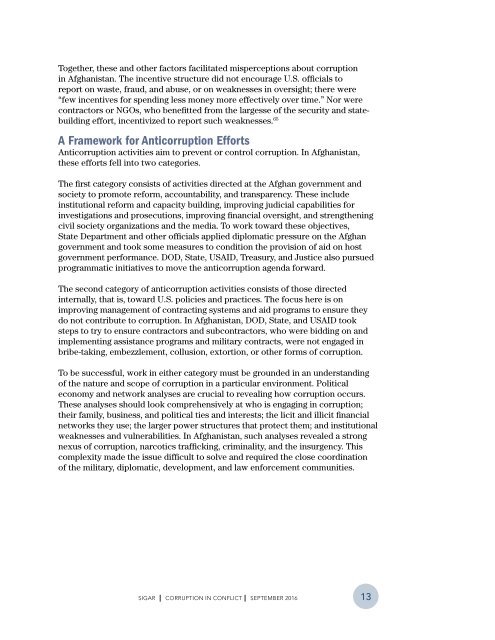CORRUPTION IN CONFLICT
5IlaWjQej
5IlaWjQej
Create successful ePaper yourself
Turn your PDF publications into a flip-book with our unique Google optimized e-Paper software.
Together, these and other factors facilitated misperceptions about corruption<br />
in Afghanistan. The incentive structure did not encourage U.S. officials to<br />
report on waste, fraud, and abuse, or on weaknesses in oversight; there were<br />
“few incentives for spending less money more effectively over time.” Nor were<br />
contractors or NGOs, who benefitted from the largesse of the security and statebuilding<br />
effort, incentivized to report such weaknesses. 65<br />
A Framework for Anticorruption Efforts<br />
Anticorruption activities aim to prevent or control corruption. In Afghanistan,<br />
these efforts fell into two categories.<br />
The first category consists of activities directed at the Afghan government and<br />
society to promote reform, accountability, and transparency. These include<br />
institutional reform and capacity building, improving judicial capabilities for<br />
investigations and prosecutions, improving financial oversight, and strengthening<br />
civil society organizations and the media. To work toward these objectives,<br />
State Department and other officials applied diplomatic pressure on the Afghan<br />
government and took some measures to condition the provision of aid on host<br />
government performance. DOD, State, USAID, Treasury, and Justice also pursued<br />
programmatic initiatives to move the anticorruption agenda forward.<br />
The second category of anticorruption activities consists of those directed<br />
internally, that is, toward U.S. policies and practices. The focus here is on<br />
improving management of contracting systems and aid programs to ensure they<br />
do not contribute to corruption. In Afghanistan, DOD, State, and USAID took<br />
steps to try to ensure contractors and subcontractors, who were bidding on and<br />
implementing assistance programs and military contracts, were not engaged in<br />
bribe-taking, embezzlement, collusion, extortion, or other forms of corruption.<br />
To be successful, work in either category must be grounded in an understanding<br />
of the nature and scope of corruption in a particular environment. Political<br />
economy and network analyses are crucial to revealing how corruption occurs.<br />
These analyses should look comprehensively at who is engaging in corruption;<br />
their family, business, and political ties and interests; the licit and illicit financial<br />
networks they use; the larger power structures that protect them; and institutional<br />
weaknesses and vulnerabilities. In Afghanistan, such analyses revealed a strong<br />
nexus of corruption, narcotics trafficking, criminality, and the insurgency. This<br />
complexity made the issue difficult to solve and required the close coordination<br />
of the military, diplomatic, development, and law enforcement communities.<br />
SIGAR I <strong>CORRUPTION</strong> <strong>IN</strong> <strong>CONFLICT</strong> I SEPTEMBER 2016<br />
13


